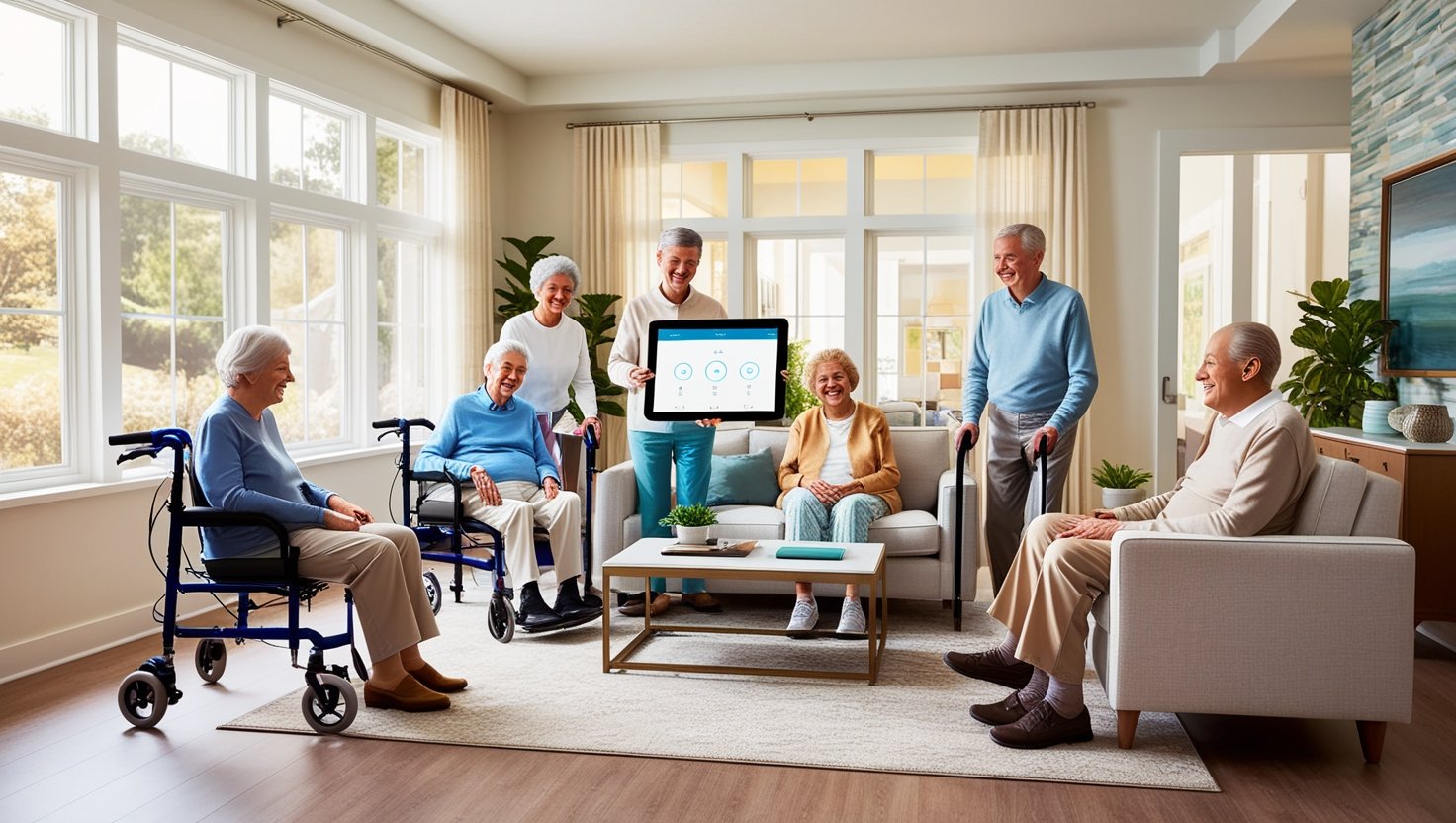As we get older, staying safe and independent at home becomes even more important. Smart home technology can make a big difference. From voice-activated lights to security systems that provide peace of mind, smart devices help seniors live comfortably and confidently. The good news? You don’t need to spend a fortune to set up a great system.
In this article, we’ll show you how to create a smart home for seniors on a budget. We’ll walk you through choosing affordable smart devices that make daily life easier and safer. Plus, we’ll share tips to help both seniors and their families feel secure and connected. Let’s explore cost-effective options and practical advice so you can give the seniors in your life the benefits of smart technology—without overspending. For more helpful resources and tips, be sure to visit SeniorThrive.
Understanding Smart Home Essentials
When it comes to setting up a smart home for seniors, it’s essential to focus on the right devices that can genuinely enhance their daily lives. Some basic yet necessary devices include smart speakers, smart lights, and security systems. These tools not only make daily tasks easier but can also provide peace of mind for both seniors and their family members. For example, a smart speaker like the Amazon Echo can help seniors listen to music, set timers for medication reminders, or even place calls with simple voice commands. Meanwhile, smart lighting can adjust brightness automatically based on the time of day, helping prevent falls in dimly lit areas.
When choosing tech solutions tailored for senior users, there are several key features to keep in mind. Look for devices that offer voice control—this hands-free feature is particularly beneficial if dexterity or vision is an issue. Simple interfaces are also crucial; devices should have intuitive controls so seniors don’t feel overwhelmed by complex technology. Moreover, ensure that any device you select is compatible with others in your chosen system; this makes setup easier and ensures they work seamlessly together as part of your DIY smart home setup.
In terms of budget-conscious priorities, it’s wise to start with essential items before expanding to more advanced technologies. Focus first on securing safety and convenience with items like motion-sensor lights and basic monitoring systems. You might consider investing a little more into these high-impact options initially rather than spreading out a small budget over numerous less useful gadgets. As you get comfortable with how to set up a smart home for seniors, additional upgrades like energy-efficient thermostats or even video doorbells can be added later without overwhelming the budget at once.
Ultimately, building a solid foundation with fundamental devices leads to a successful and cost-effective smart home setup that promotes independence and safety for seniors while remaining friendly on finances.
Choosing Budget-Friendly Smart Devices

When looking to set up an affordable smart home, the first step is selecting budget-friendly smart devices that fit your needs. Starting with smart speakers and assistants, options like the Amazon Echo Dot or Google Nest Mini are excellent choices. These small yet powerful devices can play music, answer questions, set reminders, and even control other smart home gadgets using just voice commands. They often go on sale and can be found at prices around $50 or less, making them accessible for seniors who want a simple way to manage their daily tasks without breaking the bank.
Moving on to smart lighting, there are several efficient options that enhance safety while also being cost-effective. Brands like Wyze offer smart bulbs that you can control remotely or with a voice assistant. Imagine being able to turn on lights before entering a room or dimming them from your seat—all through your phone or voice! This not only helps in reducing tripping hazards during nighttime walks but also creates a cozy living environment that meets individual preferences. Installing these smart lights is usually as simple as replacing regular bulbs, so there’s no need for complicated wiring.
Lastly, incorporating smart security systems into your affordable home automation setup can give added peace of mind without substantial costs. Consider options like Ring’s doorbell cameras or Blink’s security cameras, which allow you to monitor entry points remotely via a smartphone app. Some systems even provide free cloud storage for video footage! These devices help family members keep tabs on their loved ones’ safety while maintaining privacy and ease of use—essential factors when choosing technology for seniors. With many setups available under $100, it’s possible to create a secure environment without overspending.
By selecting these budget-friendly devices wisely, seniors can enjoy the benefits of modern technology tailored to their needs while enhancing overall comfort and safety in their homes.
Setting Up Your Smart Home Hub
Creating a central hub for your smart home is a great way to start your journey into smart living. The hub acts as the control center, linking all your devices so you can manage them through one app or voice command. To set it up, begin by choosing a reliable smart speaker or display. Options like the Amazon Echo or Google Nest Hub are good choices because they’re hands-free and work with many devices. Plug in the hub, download its app on your phone or tablet, and follow the prompts to connect to your Wi-Fi.
Compatibility is key when setting up your hub. Make sure your devices work well together. For example, if you choose Philips Hue smart bulbs, check that they connect easily with your speaker or display for simple voice controls. Look for labels like “Works With Alexa” or “Made for Google” to ensure your products integrate seamlessly. This makes everything run smoothly, which is especially important for senior safety and convenience.
After connecting your devices, automate tasks to simplify daily routines. Set schedules for lights to turn on at sunset or create routines for multiple actions. For instance, you can set a bedtime routine to turn off the lights and lock doors all at once. You can even use voice commands to set reminders for medication. Start small, and add more devices as you get comfortable with the technology.
Lastly, make sure your Wi-Fi signal is strong in the areas where your devices are set up. Weak connections can cause frustration later. If you run into issues, check online forums or contact customer support for help. Setting up a smart home should make life easier, not harder. Focus on creating a system that enhances both convenience and safety, giving you peace of mind.
DIY Installation Tips for Seniors
Setting up your smart home doesn’t have to be a daunting task, especially when you have affordable assistive technology for the elderly on your side. Many of the devices available today are designed with user-friendliness in mind, allowing seniors to install them without needing professional help. The key is to take it one step at a time and not rush into things.
If you’re someone who prefers visual guides over written instructions, there are plenty of online resources and tutorials that can be very helpful. YouTube is a treasure trove of demonstration videos showing how to set up different smart home devices from start to finish. Many tech enthusiasts create content specifically tailored for first-time users, so don’t hesitate to search for setups aimed at seniors. Watching someone else complete the installation can make you feel more confident as you embark on your own project.
That said, common pitfalls exist when diving into DIY installations. For instance, forgetting to check if all devices will work together can lead to frustration later down the road. Always ensure that any device you choose is compatible with your smart home hub—this will save time and prevent headaches later! Additionally, some users overlook reading reviews before making purchases; learning from others’ experiences can provide invaluable insights into what works best for a budget-friendly setup. By avoiding these common mistakes and approaching installation patiently, seniors can successfully create their own connected living environment with ease and confidence.
Ensuring Safety and Security at Home
When setting up a smart home for seniors, safety is often the top priority. Smart technology can be a game changer for fall detection, especially for older adults with mobility challenges. Some devices use sensors to monitor movement in the home. For example, motion detectors can send alerts to family members or caregivers if there’s no movement for a long time. This ensures help arrives quickly, giving peace of mind to seniors and their loved ones.
Monitoring systems are another great way to stay connected. Affordable smart cameras and video doorbells let families check in remotely. These devices offer live streaming and send notifications if there’s unexpected activity. Many even have two-way audio, so seniors can talk directly with family members through a smartphone or tablet. These tools not only improve security but also help families feel closer, no matter the distance.
It’s important to think about privacy and data security when adding smart devices to a home. While these gadgets can make life easier, basic security practices are a must. Seniors should use unique passwords and update them regularly. They should also review device privacy settings to ensure only necessary information is shared. Taking these simple steps protects personal data while allowing seniors to enjoy the benefits of smart technology.
By combining safety features, connectivity, and security, families can create a smart home that supports independence and well-being. With today’s technology, it’s easier than ever to design a secure and comfortable environment tailored to seniors’ needs.
Training Seniors to Use Smart Technology
Teaching seniors how to use smart technology is an important step for a successful setup. Everyone learns differently, so it’s good to adapt training to their needs. Some may prefer one-on-one lessons, while others might enjoy group sessions where they can ask questions and share experiences. Understanding their comfort level with technology makes learning less overwhelming and more supportive.
Creating simple guides or cheat sheets is another helpful strategy. Use large fonts, clear images, and straightforward language to make instructions easy to follow. For example, if you’re teaching a senior how to adjust smart lighting, create a step-by-step guide. Show each button and explain what it does. This way, they can handle things on their own later without feeling lost. Having these resources can boost their confidence and make technology feel more approachable.
To make learning fun, try engaging seniors in real-life scenarios. Instead of just explaining how to set up voice commands, turn it into a game. Give points for completing commands correctly. This makes learning interactive and enjoyable. Fun activities not only build skills but also create positive memories, making technology less intimidating. With a playful approach, seniors are more likely to stay motivated and remember what they learn.
In short, effective training means understanding their needs, creating easy materials, and making learning enjoyable. By doing this, you can help seniors use smart technology confidently, fostering independence while ensuring their safety at home.
Maintaining Your Smart Home Setup

Once your smart home is set up, the next step is keeping it running smoothly. Regular updates and device checks are key. Many smart devices get software updates that improve their features or security. For example, updating your smart speaker might add new features like better voice recognition or skills tailored for seniors. Setting a monthly reminder can help ensure everything stays up-to-date and works as it should.
Troubleshooting is also an important part of maintenance. Seniors might face issues like smart lights not turning on or the thermostat not adjusting correctly. Getting help from family members or caregivers can make these situations less stressful. Simple fixes, like restarting devices or checking the Wi-Fi, often solve most problems. You can also create easy-to-follow guides for common issues. These step-by-step instructions help seniors handle problems without feeling overwhelmed.
For more complex issues, there are plenty of resources available. Many manufacturers offer customer support hotlines to assist with technical questions. Online forums and community groups can also be great for advice from other smart home users. Using these resources can make it easier for seniors to overcome challenges and enjoy their smart home setup.
By focusing on regular checks, simple troubleshooting, and helpful resources, you can keep your senior loved one’s smart home working well. This creates a safe and comfortable environment where they can enjoy greater independence and confidence.
Embracing a Smarter Home
Setting up an affordable smart home for seniors offers many benefits. It can enhance safety, improve convenience, and foster independence. With thoughtful planning and simple devices, you can create a space that supports a more comfortable lifestyle. Seniors can enjoy features like voice-activated assistants, automated lighting, and security systems without overwhelming costs.
Taking the first step toward smarter living is easier than it seems. Start by choosing just one or two devices that meet your needs. As you grow familiar with how to set up a smart home for seniors, you’ll discover even more advantages. Embrace this technology to boost safety and enjoy everyday life more fully. Remember, every little change can make a big difference!



